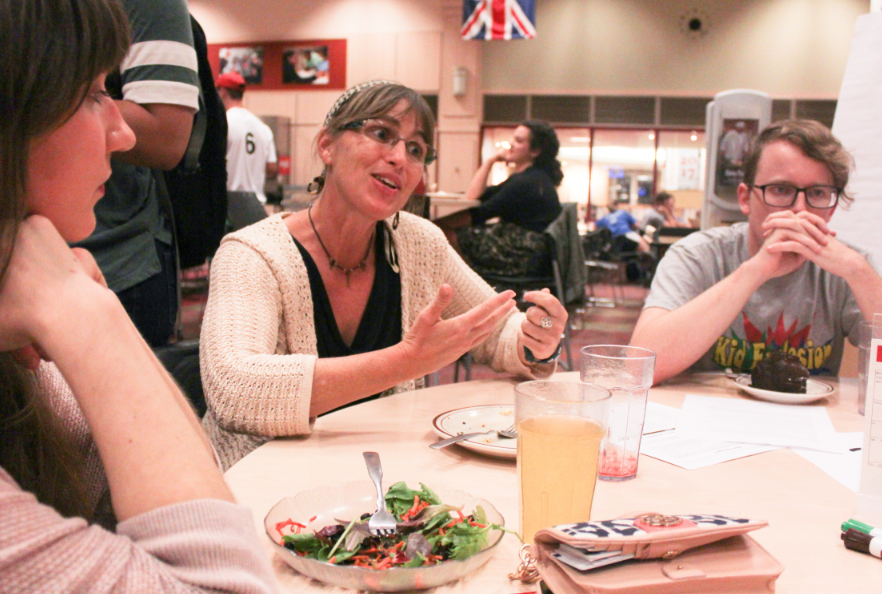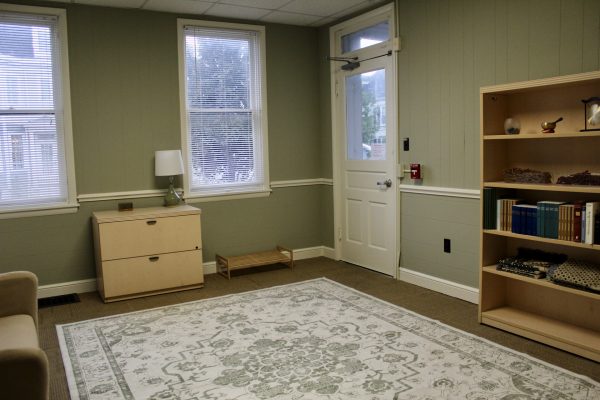Second Dialogue to Action Event Takes over Dining Hall
Community members discuss socioeconomic and racial divisions on campus during the Oct. 21 dialogue.
The second Dialogue to Action event took place on Wednesday, Oct. 21 at 6:30 p.m. in the Dining Hall, facilitating conversations about socioeconomic and racial divisions within the Dickinson community.
Since the event took place during normal dining hours, the idea was to get students eating dinner involved in the dialogue and to promote conversation among all students. Attendees were encouraged to sit at one of the eight designated tables in the middle of the caf where questions were prompted to start the individualized conversations. From there, the students continued the dialogue by asking their own questions of each other and bringing their own ideas and opinions to the table.
The prompting questions ranged from opinions about the inclusivity of the Dickinson community to if and how socioeconomic background plays a role in how students interact with each other on campus. Before the event began, students were equipped with a “Dialogues vocabulary” handout that included definitions of terms such as ‘classism,’ ‘equity,’ ‘intersectionality’ and ‘social justice.’
Cameron O’Shaughnessy ’16 said that he sees a “pretty clear” divide on campus, not just on the socioeconomic or racial levels, but with sports, clubs and other groups on campus.
“I think we have to be careful when talking about divisions and divides because they aren’t always the typical race and class [divides],” O’Shaughnessy said. “They’re within every layer of our school.”
Morten von Glan ’16 did not see the divides the same way, especially in light of socioeconomic situations:
“Everyone has to somehow pay tuition…I don’t think there are any poor people on campus,” he commented. “Or if there are, they’re under a lot of pressure to hide it.”
Mollie Montague ’19 agreed with von Glan about the pressures of hiding an aspect of one’s personality or background in order to fit in better with the majorities on campus.
“I’m from the South, and I learned very quickly that if I spoke with a Southern accent I’d be taken less seriously,” said Montague.
The next questions addressed how these divides could be fixed and if Dickinson is currently doing a good enough job doing so.
Many students, including Evan Davis ’16, believed that changing distribution requirements of the academic curriculum could help absolve the problem of divisions within the community and promote understanding of different backgrounds.
“I think [Dickinson] should make an Africana studies or Women and Gender studies class mandatory,” Davis stated. Many students agreed with this perspective as a means to reduce the levels of ignorance, however most were doubtful that the problem could ever truly be eradicated.
“It gets better but it doesn’t get fixed,” O’Shaughnessy stated. “It’s always going to be an underlying force in a society that is capitalist with money as the driving force…it gets better but can’t be fixed.”
Von Glan agreed with O’Shaughnessy, as well as others who were unsure about the prospects of full and unbiased inclusivity on campus.
“[We’re just] wealthy kids 18-23… [We] don’t get that real world experience inside of the college bubble,” Von Glan stated. “Some people have a very narrow view.”
The dialogue then shifted to a comparison of the divisions on the Dickinson campus versus the rest of the United States.
“This place is definitely more liberal and inclusive than the rest of the country,” Joseph Frank ’16 said. Many students present agreed with Frank that despite the divisions they see on campus, it is a more accepting and understanding place than the rest of America.
The Dean of Students, the Popel Shaw Center for Race and Ethnicity, Student Senate and Sustained Dialogue sponsored this event.Co




